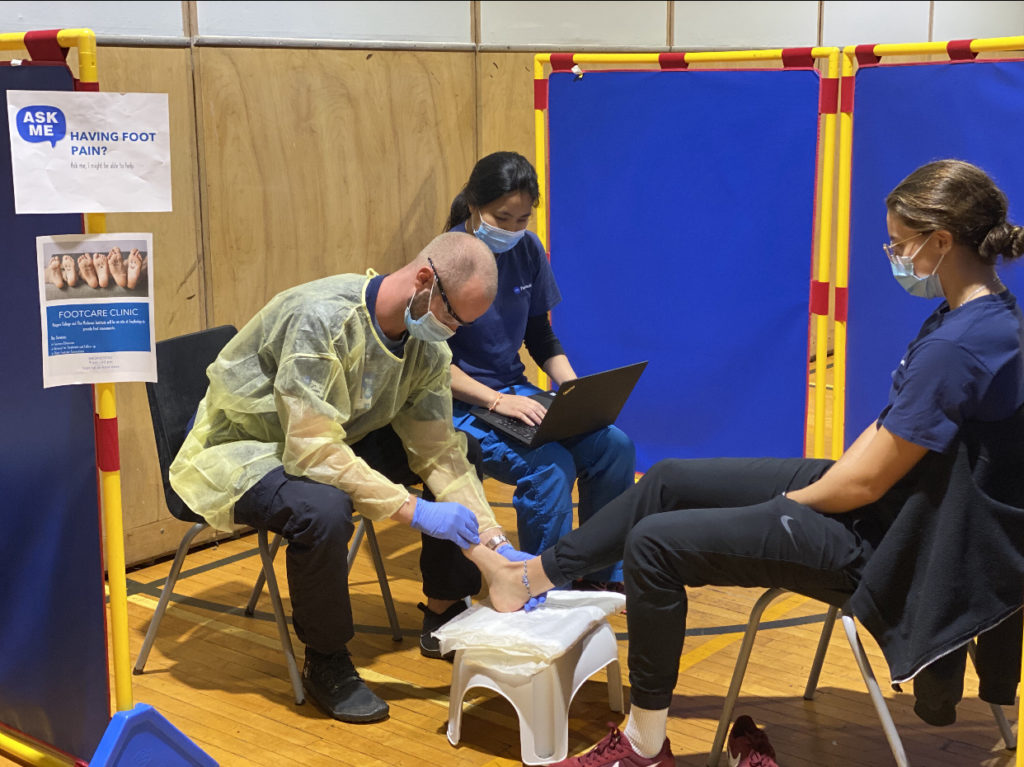
Angela Seng knows that good foot care is essential to good health.
But the second-year Paramedic student also knows it’s easy to overlook the body part that pounds countless kilometres of pavement every day, especially when someone has more pressing priorities, such as securing food and shelter.
That lesson is reinforced regularly for Seng. She was hired during Spring term 2021 to help establish a foot care pilot program at Southridge Shelter in St. Catharines, which will serve to develop the skills of students from various Niagara College (NC) health care programs while helping shelter residents.
It’s at Southridge, meeting people dealing with issues of homelessness, that Seng sees the effects of ill-fitting shoes, worn-out footwear, and callouses or toenails in need of care and trimming.
And it’s there during weekly visits that Seng, along with four other Paramedic students, has assessed, triaged and provided referrals for more in-depth foot care by doctors and nurses when shelter residents need it.
“Foot health gets overlooked,” Seng said. “Most people don’t have knowledge of foot care health. It’s education. Good foot care is good health.”
The assistance Seng provides at Southridge was made possible by a grant of $209,576 spread over two years from the Natural Sciences and Engineering Research Council (NSERC) College and Community Social Innovation Fund (CCSIF).
The money, awarded in 2020, enables Niagara College and its academic and community partners to address access to health care for those needing essential foot care, and improve implementation by health-care professionals at homeless shelters.
It’s the first grant of its kind for NC. So far, the money has been used by the College’s Research & Innovation division to hire students from the Personal Support Worker; Paramedic; Advanced Care Paramedic; Occupational Therapist Assistant and Physiotherapist Assistant; and Practical Nursing programs to establish the pilot at Southridge.
Using a train-the-trainer model, students will also mentor their peers to administer the program going forward and earn program placement hours in the process.
The project, which is a collaboration with the Michener Institute of Education at UHN’s Chiropody program, is managed by the Centre for Health, Wellness and Aging within NC’s Community and Health Studies division.
“It’s a matter of making it a primarily experiential learning opportunity for students,” said Carolyn Triemstra, dean of Community and Health Studies. “It’s been a lot of work but the success we’ve seen each week as students go into the shelter has been amazing.”
Annie Froese, shelter director at Southridge, said residents are coming to the clinic with a wide range of issues, from needing new shoes, a single treatment, such as nail trimming, or ongoing therapy, which is provided by REACH, a primary care provider for homeless and marginalized populations in Niagara.
To help with footwear issues, students in the College’s Social Service Worker program secured shoe donations to help solve footwear issues, underscoring the interdisciplinary approach of the program.
“A lot of our guys wouldn’t self-assess where their feet are at,” Froese said. “It’s one of those aspects of health that comes from a place of privilege. Other things are going well in life so you can pay attention to that.”
Paramedicine, like what’s offered at the Southridge foot care clinic, is increasingly becoming part of a paramedic’s job description and Niagara is a leader in it with EMTs part of mobile health teams that provide targeted services to lessen the volume of 911 calls and alleviate emergency triage pressures.
“It’s helping students understand the scope of the role as paramedics,” Triemstra said.
Still, the care provided in the pilot is critical, explained Catharine Gray, the Michener Institute’s academic chair and discipline head of Chiropody. The rate of lower-limb amputation in Ontario, particularly related diabetes, is one every four hours, taxing the health-care system once hospitalization and rehabilitation are considered.
Programs like this one can help to change that statistic.
“For the most part, people don’t think of feet until there’s a problem and at that point, it may be too late,” said Gray, who spearheaded the project.
The Michener Institute, which offers a three-year postgraduate Chiropody program focused on the assessment and management of foot and lower-limb conditions, is collaborating with the College to co-develop the educational model and resources required to educate and train NC students.
Gray, who hails from Niagara Falls, hopes to see the program expand beyond Southridge, to reach others needing similar care.
“There’s lots of opportunities for foot screening to increase across all populations,” she said. “This is a population that really needs care and support.”